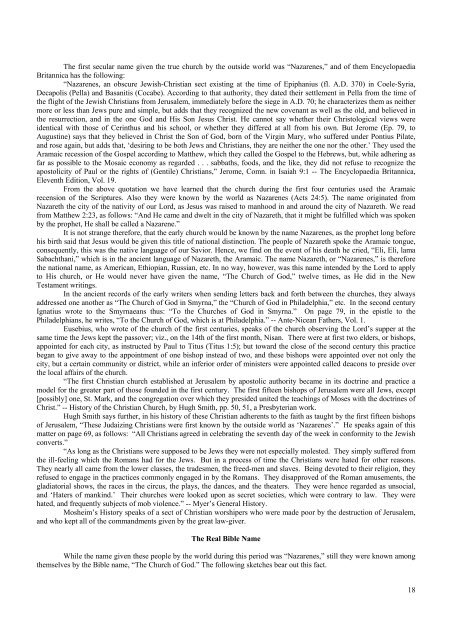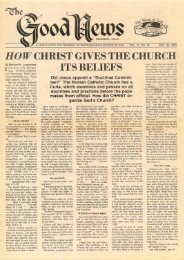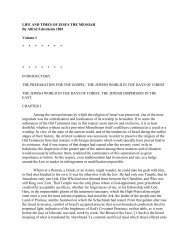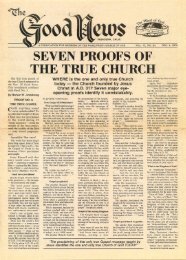History of the True Religion Traced from 33AD to Date - Lcgmn.com
History of the True Religion Traced from 33AD to Date - Lcgmn.com
History of the True Religion Traced from 33AD to Date - Lcgmn.com
You also want an ePaper? Increase the reach of your titles
YUMPU automatically turns print PDFs into web optimized ePapers that Google loves.
The first secular name given <strong>the</strong> true church by <strong>the</strong> outside world was “Nazarenes,” and <strong>of</strong> <strong>the</strong>m Encyclopaedia<br />
Britannica has <strong>the</strong> following:<br />
“Nazarenes, an obscure Jewish-Christian sect existing at <strong>the</strong> time <strong>of</strong> Epiphanius (fl. A.D. 370) in Coele-Syria,<br />
Decapolis (Pella) and Basanitis (Cocabe). According <strong>to</strong> that authority, <strong>the</strong>y dated <strong>the</strong>ir settlement in Pella <strong>from</strong> <strong>the</strong> time <strong>of</strong><br />
<strong>the</strong> flight <strong>of</strong> <strong>the</strong> Jewish Christians <strong>from</strong> Jerusalem, immediately before <strong>the</strong> siege in A.D. 70; he characterizes <strong>the</strong>m as nei<strong>the</strong>r<br />
more or less than Jews pure and simple, but adds that <strong>the</strong>y recognized <strong>the</strong> new covenant as well as <strong>the</strong> old, and believed in<br />
<strong>the</strong> resurrection, and in <strong>the</strong> one God and His Son Jesus Christ. He cannot say whe<strong>the</strong>r <strong>the</strong>ir Chris<strong>to</strong>logical views were<br />
identical with those <strong>of</strong> Cerinthus and his school, or whe<strong>the</strong>r <strong>the</strong>y differed at all <strong>from</strong> his own. But Jerome (Ep. 79, <strong>to</strong><br />
Augustine) says that <strong>the</strong>y believed in Christ <strong>the</strong> Son <strong>of</strong> God, born <strong>of</strong> <strong>the</strong> Virgin Mary, who suffered under Pontius Pilate,<br />
and rose again, but adds that, ‘desiring <strong>to</strong> be both Jews and Christians, <strong>the</strong>y are nei<strong>the</strong>r <strong>the</strong> one nor <strong>the</strong> o<strong>the</strong>r.’ They used <strong>the</strong><br />
Aramaic recession <strong>of</strong> <strong>the</strong> Gospel according <strong>to</strong> Mat<strong>the</strong>w, which <strong>the</strong>y called <strong>the</strong> Gospel <strong>to</strong> <strong>the</strong> Hebrews, but, while adhering as<br />
far as possible <strong>to</strong> <strong>the</strong> Mosaic economy as regarded . . . sabbaths, foods, and <strong>the</strong> like, <strong>the</strong>y did not refuse <strong>to</strong> recognize <strong>the</strong><br />
apos<strong>to</strong>licity <strong>of</strong> Paul or <strong>the</strong> rights <strong>of</strong> (Gentile) Christians,” Jerome, Comn. in Isaiah 9:1 -- The Encyclopaedia Britannica,<br />
Eleventh Edition, Vol. 19.<br />
From <strong>the</strong> above quotation we have learned that <strong>the</strong> church during <strong>the</strong> first four centuries used <strong>the</strong> Aramaic<br />
recension <strong>of</strong> <strong>the</strong> Scriptures. Also <strong>the</strong>y were known by <strong>the</strong> world as Nazarenes (Acts 24:5). The name originated <strong>from</strong><br />
Nazareth <strong>the</strong> city <strong>of</strong> <strong>the</strong> nativity <strong>of</strong> our Lord, as Jesus was raised <strong>to</strong> manhood in and around <strong>the</strong> city <strong>of</strong> Nazareth. We read<br />
<strong>from</strong> Mat<strong>the</strong>w 2:23, as follows: “And He came and dwelt in <strong>the</strong> city <strong>of</strong> Nazareth, that it might be fulfilled which was spoken<br />
by <strong>the</strong> prophet, He shall be called a Nazarene.”<br />
It is not strange <strong>the</strong>refore, that <strong>the</strong> early church would be known by <strong>the</strong> name Nazarenes, as <strong>the</strong> prophet long before<br />
his birth said that Jesus would be given this title <strong>of</strong> national distinction. The people <strong>of</strong> Nazareth spoke <strong>the</strong> Aramaic <strong>to</strong>ngue,<br />
consequently, this was <strong>the</strong> native language <strong>of</strong> our Savior. Hence, we find on <strong>the</strong> event <strong>of</strong> his death he cried, “Eli, Eli, lama<br />
Sabachthani,” which is in <strong>the</strong> ancient language <strong>of</strong> Nazareth, <strong>the</strong> Aramaic. The name Nazareth, or “Nazarenes,” is <strong>the</strong>refore<br />
<strong>the</strong> national name, as American, Ethiopian, Russian, etc. In no way, however, was this name intended by <strong>the</strong> Lord <strong>to</strong> apply<br />
<strong>to</strong> His church, or He would never have given <strong>the</strong> name, “The Church <strong>of</strong> God,” twelve times, as He did in <strong>the</strong> New<br />
Testament writings.<br />
In <strong>the</strong> ancient records <strong>of</strong> <strong>the</strong> early writers when sending letters back and forth between <strong>the</strong> churches, <strong>the</strong>y always<br />
addressed one ano<strong>the</strong>r as “The Church <strong>of</strong> God in Smyrna,” <strong>the</strong> “Church <strong>of</strong> God in Philadelphia,” etc. In <strong>the</strong> second century<br />
Ignatius wrote <strong>to</strong> <strong>the</strong> Smyrnaeans thus: “To <strong>the</strong> Churches <strong>of</strong> God in Smyrna.” On page 79, in <strong>the</strong> epistle <strong>to</strong> <strong>the</strong><br />
Philadelphians, he writes, “To <strong>the</strong> Church <strong>of</strong> God, which is at Philadelphia.” -- Ante-Nicean Fa<strong>the</strong>rs, Vol. 1.<br />
Eusebius, who wrote <strong>of</strong> <strong>the</strong> church <strong>of</strong> <strong>the</strong> first centuries, speaks <strong>of</strong> <strong>the</strong> church observing <strong>the</strong> Lord’s supper at <strong>the</strong><br />
same time <strong>the</strong> Jews kept <strong>the</strong> passover; viz., on <strong>the</strong> 14th <strong>of</strong> <strong>the</strong> first month, Nisan. There were at first two elders, or bishops,<br />
appointed for each city, as instructed by Paul <strong>to</strong> Titus (Titus 1:5); but <strong>to</strong>ward <strong>the</strong> close <strong>of</strong> <strong>the</strong> second century this practice<br />
began <strong>to</strong> give away <strong>to</strong> <strong>the</strong> appointment <strong>of</strong> one bishop instead <strong>of</strong> two, and <strong>the</strong>se bishops were appointed over not only <strong>the</strong><br />
city, but a certain <strong>com</strong>munity or district, while an inferior order <strong>of</strong> ministers were appointed called deacons <strong>to</strong> preside over<br />
<strong>the</strong> local affairs <strong>of</strong> <strong>the</strong> church.<br />
“The first Christian church established at Jerusalem by apos<strong>to</strong>lic authority became in its doctrine and practice a<br />
model for <strong>the</strong> greater part <strong>of</strong> those founded in <strong>the</strong> first century. The first fifteen bishops <strong>of</strong> Jerusalem were all Jews, except<br />
[possibly] one, St. Mark, and <strong>the</strong> congregation over which <strong>the</strong>y presided united <strong>the</strong> teachings <strong>of</strong> Moses with <strong>the</strong> doctrines <strong>of</strong><br />
Christ.” -- <strong>His<strong>to</strong>ry</strong> <strong>of</strong> <strong>the</strong> Christian Church, by Hugh Smith, pp. 50, 51, a Presbyterian work.<br />
Hugh Smith says fur<strong>the</strong>r, in his his<strong>to</strong>ry <strong>of</strong> <strong>the</strong>se Christian adherents <strong>to</strong> <strong>the</strong> faith as taught by <strong>the</strong> first fifteen bishops<br />
<strong>of</strong> Jerusalem, “These Judaizing Christians were first known by <strong>the</strong> outside world as ‘Nazarenes’.” He speaks again <strong>of</strong> this<br />
matter on page 69, as follows: “All Christians agreed in celebrating <strong>the</strong> seventh day <strong>of</strong> <strong>the</strong> week in conformity <strong>to</strong> <strong>the</strong> Jewish<br />
converts.”<br />
“As long as <strong>the</strong> Christians were supposed <strong>to</strong> be Jews <strong>the</strong>y were not especially molested. They simply suffered <strong>from</strong><br />
<strong>the</strong> ill-feeling which <strong>the</strong> Romans had for <strong>the</strong> Jews. But in a process <strong>of</strong> time <strong>the</strong> Christians were hated for o<strong>the</strong>r reasons.<br />
They nearly all came <strong>from</strong> <strong>the</strong> lower classes, <strong>the</strong> tradesmen, <strong>the</strong> freed-men and slaves. Being devoted <strong>to</strong> <strong>the</strong>ir religion, <strong>the</strong>y<br />
refused <strong>to</strong> engage in <strong>the</strong> practices <strong>com</strong>monly engaged in by <strong>the</strong> Romans. They disapproved <strong>of</strong> <strong>the</strong> Roman amusements, <strong>the</strong><br />
gladia<strong>to</strong>rial shows, <strong>the</strong> races in <strong>the</strong> circus, <strong>the</strong> plays, <strong>the</strong> dances, and <strong>the</strong> <strong>the</strong>aters. They were hence regarded as unsocial,<br />
and ‘Haters <strong>of</strong> mankind.’ Their churches were looked upon as secret societies, which were contrary <strong>to</strong> law. They were<br />
hated, and frequently subjects <strong>of</strong> mob violence.” -- Myer’s General <strong>His<strong>to</strong>ry</strong>.<br />
Mosheim’s <strong>His<strong>to</strong>ry</strong> speaks <strong>of</strong> a sect <strong>of</strong> Christian worshipers who were made poor by <strong>the</strong> destruction <strong>of</strong> Jerusalem,<br />
and who kept all <strong>of</strong> <strong>the</strong> <strong>com</strong>mandments given by <strong>the</strong> great law-giver.<br />
The Real Bible Name<br />
While <strong>the</strong> name given <strong>the</strong>se people by <strong>the</strong> world during this period was “Nazarenes,” still <strong>the</strong>y were known among<br />
<strong>the</strong>mselves by <strong>the</strong> Bible name, “The Church <strong>of</strong> God.” The following sketches bear out this fact.<br />
18












